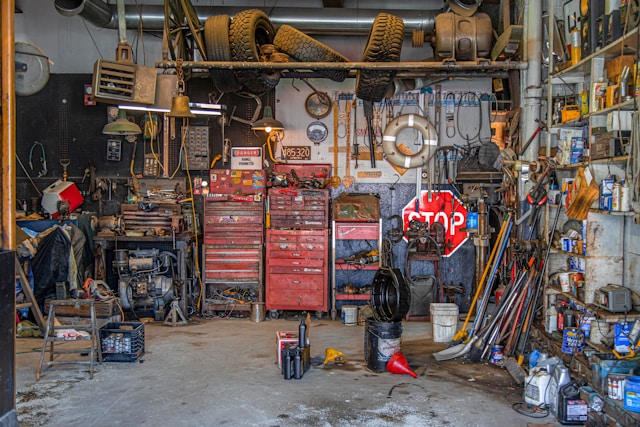
Is your garage a dumping ground for everything except your car? You’re not alone. For many people, the garage slowly turns into a no-go zone, stuffed with old furniture, broken tools, seasonal junk, and piles of things that “might come in handy one day.” Sound familiar?
It doesn’t have to be this way. With the right approach, you can turn your garage into a functional, organised space. One that actually serves a purpose, whether that’s parking the car, setting up a workshop, or simply storing your stuff in a way that doesn’t feel overwhelming.
Step One: Start With Garage Clearance Services
Before anything else, clear the space. If your garage is packed to the brim, sorting through it all on your own can take days or even weeks. This is where garage clearance services come in. They take care of the heavy lifting, dispose of junk responsibly, and free up space so you can actually see what you’re working with.
They’re especially useful if you’ve got:
- Bulky items – Things like broken furniture, unused gym equipment, or old white goods.
- Large quantities – Years of clutter can add up quickly, and bagging it all yourself is a huge task.
- Limited time – If you just want the job done and dusted without dragging it out.
Once the rubbish is gone, you’re left with a clean slate. From here, the real organising begins.
Step Two: Categorise What’s Left
Don’t start buying storage containers just yet. First, figure out what you actually own. The easiest way is to sort everything into broad categories. This will help you decide what needs to stay, what can go, and how much space each type of item requires.
Common categories include:
- Tools – Hand tools, power tools, garden tools.
- Sport and leisure – Bikes, camping gear, fitness equipment.
- Car maintenance – Oil, fluids, spare parts, cleaning supplies.
- Seasonal – Decorations, fans, heaters.
- Sentimental or archive – Old photos, keepsakes, files.
You might notice duplicates or things you haven’t used in years. Be realistic. If it’s been sitting untouched for over 12 months, chances are, you won’t miss it. Donate, sell, or responsibly dispose of it.
Step Three: Define Zones Within the Garage
Now that you’ve sorted through everything, it’s time to decide where each type of item should live. One of the most effective ways to keep a garage organised is to divide it into zones. That means assigning specific areas of the garage for specific types of belongings.
For example, you might use one side for tools and DIY supplies, another for bikes and sports gear, and a shelving section for car-related products like oil and cleaning supplies. Seasonal items that you don’t need often, such as holiday decorations or fans, can be placed higher up or tucked away toward the back.
Creating zones makes it easier to store things in a consistent way. You’ll know where everything goes, which stops clutter from building up again. If it helps, you can sketch out a quick layout to guide how you place items back in the space.
Step Four: Choose Storage That Suits the Space
Not all garages are the same size or shape, and what works for one might not suit another. The trick is to maximise vertical space and keep the floor as clear as possible. This not only looks better but also makes it easier to move around and reach what you need.
Think about using strong shelving units for heavier items like paint cans or tools. Wall-mounted racks and pegboards are great for things like spades, drills, or sports accessories. If your garage ceiling is high enough, overhead storage is a smart option for bulky but lightweight items you only need occasionally.
Clear containers can help too, as they let you see what’s inside without having to open each one. Just make sure they stack well and are easy to access. Try not to overfill the space. Leave room to grow, so you don’t find yourself back at square one the next time you buy something new.
Step Five: Keep the Essentials Easy to Reach
Not everything in your garage needs to be front and centre. Some items are used regularly, while others only come out once or twice a year. The key is to think about how often you use each item and organise around that.
For anything you reach for frequently – like your toolbox, bike pump, or garden gloves – store it in a spot that doesn’t require effort to access. That means avoiding high shelves or the back corner. Save those spots for things like Christmas decorations or extra paint tins that you won’t touch for months.
It might sound like a small detail, but making everyday items easy to grab helps keep everything running smoothly. You’re far more likely to put things back properly when the process is quick and painless.
Step Six: Use Labels, Even If It Feels Obvious
Once everything has a place, add labels. It might feel like overkill, but labels prevent confusion and save time, especially if more than one person uses the garage. You don’t want to spend ten minutes opening every box just to find a screwdriver.
Simple labels work best. Avoid long-winded descriptions – just write what’s in the box or what that shelf is for. You can use masking tape and a marker or invest in something more permanent if you prefer a neater look. The main goal is to make everything visible at a glance.
For extra organisation, especially with boxes that contain several items, consider numbering them and jotting down a quick list of what’s inside. It takes an extra minute, but it can make a big difference later on when you’re trying to find something specific.
Step Seven: Create a Habit of Maintenance
The final step? Keep it that way.
Organisation isn’t a one-time event. It’s a habit. But once your garage is set up properly, maintaining it becomes much easier. Try to:
- Do a quick check monthly – Clear up anything that’s out of place.
- Schedule a seasonal refresh – Use the change in seasons as a reminder to reassess what’s in storage.
- Avoid using the garage as a temporary dumping ground – If something doesn’t belong, deal with it straight away.
You’ve already done the hard part. Keeping it clean just takes a little regular effort.
A Space That Works For You
When your garage is set up properly, it stops being a place you avoid. It becomes a space that works with your life, not against it. Whether you’re parking the car, storing seasonal bits, or finally getting around to DIY projects, an organised garage saves time, stress, and space.
All it takes is a clear plan, the right storage, and a little regular effort. And remember, it all begins with that first big clear-out. Everything else becomes much easier from there.




